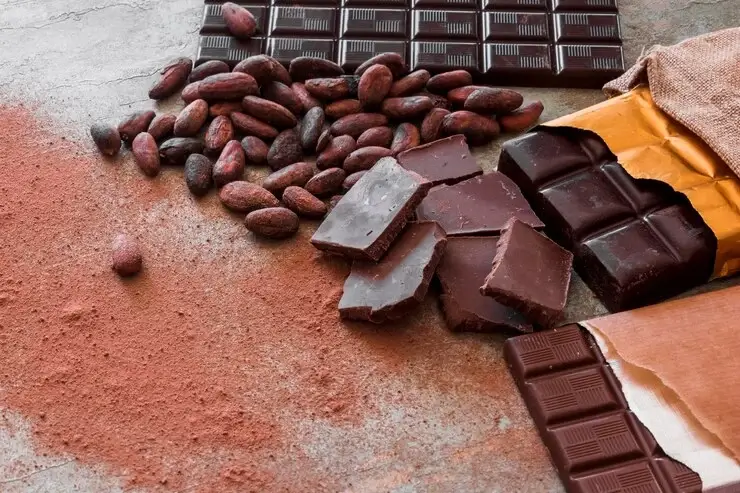
Why Paraffin Appears in Chocolate
If you’ve ever wondered why some chocolates shine more than others or why they don’t melt easily in your hands, you’ve discovered one of confectionery’s best-kept secrets — paraffin wax.
Paraffin in chocolate might sound strange, but it plays an important role in texture, appearance, and shelf life.
It helps keep chocolate smooth, glossy, and resistant to melting — especially in warm environments.
Table of Contents
ToggleHowever, not all paraffin is suitable for food. Only food-grade paraffin wax is approved for use in chocolate and candy-making.
What Is Paraffin Wax?
Paraffin wax is a mixture of long-chain saturated hydrocarbons derived from petroleum.
It’s colorless, tasteless, and odorless when refined to food-grade purity.
In chemistry, paraffin has the general formula CnH₂n₊₂, where “n” represents the number of carbon atoms in the molecule — typically between 20 and 40 in wax form.
This structure gives paraffin a solid, waxy texture at room temperature and allows it to melt smoothly between 47°C and 65°C (117°F–149°F).
Why Paraffin Is Used in Chocolate
When used correctly, paraffin wax offers several practical advantages in chocolate production:
1. Enhances Gloss and Shine
Paraffin gives chocolate a polished, glossy finish that makes it look more appealing.
Without it, chocolate can appear dull or streaky due to fat blooming — a white coating that forms when cocoa butter crystallizes unevenly.
2. Improves Heat Resistance
Because paraffin melts at a higher temperature than cocoa butter, it helps chocolate resist melting during handling or shipping in warm climates.
3. Extends Shelf Life
The wax forms a thin protective coating that keeps moisture and oxygen away, preventing chocolate from spoiling or losing texture.
4. Adds Structural Stability
In molded or coated candies, paraffin helps chocolate set faster and maintain its shape without becoming too soft.
How Much Paraffin Is Used in Chocolate
Manufacturers add only tiny amounts of paraffin — usually 1–2% of the total chocolate weight.
Adding more would change the texture and make the chocolate waxy or inedible.
In fact, when properly balanced, the presence of paraffin is undetectable by taste.
Most commonly, it’s added to coating chocolate, candy shells, or decorative toppings — not to the main chocolate bars or gourmet truffles you buy in stores.
Food-Grade Paraffin vs. Industrial Paraffin
It’s extremely important to understand that not all paraffin is safe to eat.
Only food-grade paraffin wax, refined under strict standards, is suitable for chocolate making.
| Type | Purity | Use |
|---|---|---|
| Food-Grade Paraffin | 99.9% pure, odorless, tasteless | Chocolate, candy coating |
| Cosmetic-Grade Paraffin | Refined for skin use | Lotions, spa treatments |
| Industrial Paraffin | Contains impurities | Lubricants, candles, packaging |
Food-grade paraffin meets safety requirements set by organizations such as the U.S. Food and Drug Administration (FDA) and the European Food Safety Authority (EFSA).
So, while paraffin in chocolate is safe when used correctly, non-food-grade wax should never be used in food.
Is Paraffin in Chocolate Safe to Eat?
Yes — food-grade paraffin wax is safe to consume in small quantities.
It’s non-digestible, meaning it passes through the body unchanged, similar to dietary fiber.
Regulatory bodies like the FDA have approved paraffin as a food additive (E905) when used within recommended limits.
Extensive testing has confirmed that it does not react chemically in the digestive system and poses no health risk at low concentrations.
However, excessive use or ingestion of non-food-grade paraffin can cause digestive discomfort.
That’s why only properly refined wax is acceptable for chocolate manufacturing.
Alternative Ingredients to Paraffin
Although paraffin remains popular, some manufacturers use natural alternatives for specific products.
| Alternative Ingredient | Source | Purpose in Chocolate |
|---|---|---|
| Cocoa Butter | Cocoa beans | Natural fat that adds shine and smoothness |
| Beeswax | Honeybees | Provides gloss and firmness |
| Carnauba Wax | Carnauba palm leaves | Plant-based, high-gloss finish |
| Shellac | Insect resin | Used for glossy coatings on candies |
Each of these options has its advantages. However, paraffin wax remains preferred for industrial-scale chocolate because of its low cost, consistency, and thermal stability.
Why Chocolate Makers Still Use Paraffin
Many artisan chocolatiers avoid wax altogether, but large-scale producers often rely on it for one simple reason — reliability.
Paraffin allows chocolate coatings to:
-
Stay solid in warm conditions
-
Resist fingerprints and smudging
-
Deliver longer shelf stability during transport
Because South Africa, the Middle East, and other warm regions face temperature challenges, food-grade paraffin remains a trusted stabilizer for industrial chocolate coatings and bars.
How Paraffin Affects Chocolate Texture and Taste
When used in small amounts, paraffin doesn’t affect chocolate’s flavor.
Instead, it slightly changes its melting behavior, creating a firmer bite and a smoother finish.
In larger quantities, though, the chocolate can feel waxy or chewy, which is why manufacturers carefully control dosage and blend it with cocoa butter.
For professional candy makers, the goal is to balance aesthetics with taste — achieving a shiny, smooth coating without compromising flavor.
Environmental and Production Considerations
Modern paraffin production has become cleaner and more sustainable.
Many refineries now use hydrotreated feedstocks and low-emission technologies to reduce impurities and carbon output.
Furthermore, food-grade paraffin can be recycled or repurposed, making it an efficient byproduct of petroleum refining rather than a waste material.
Sustainable wax alternatives like Fischer–Tropsch waxes are also gaining attention for their purity and renewable potential.
ATDM – Trusted Supplier of Food-Grade Paraffin Wax
When it comes to high-quality paraffin for food applications, ATDM stands as a reliable international supplier.
ATDM produces and exports refined food-grade paraffin wax that meets global safety standards for confectionery and coating applications.
Their products are widely used in chocolate, chewing gum, and bakery coatings, where purity and consistency are essential.
With years of expertise in petroleum chemistry and hydrocarbon refinement, ATDM ensures every batch meets strict quality, color, and purity standards.
Whether for chocolate production or industrial uses, ATDM provides trusted paraffin wax solutions that combine performance, safety, and sustainability.
Final Thoughts
Paraffin in chocolate might sound unusual, but it’s one of the many ingredients that help make your favorite treats shinier, smoother, and longer-lasting.
When sourced and used responsibly, food-grade paraffin wax is perfectly safe and highly effective in confectionery.
It represents the fascinating link between chemistry and food science, transforming ordinary chocolate into something glossy, durable, and beautiful.
And with ATDM’s premium-quality paraffin, chocolatiers and manufacturers can continue producing chocolates that look as good as they taste.

